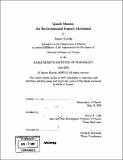Quark masses : an environmental impact statement
Author(s)
Kimchi, Itamar
DownloadFull printable version (8.237Mb)
Other Contributors
Massachusetts Institute of Technology. Dept. of Physics.
Advisor
Robert L. Jaffe.
Terms of use
Metadata
Show full item recordAbstract
We investigate how the requirement that organic chemistry be possible constrains the values of the quark masses. Specifically, we choose a slice through the parameter space of the Standard Model in which quark masses vary so that as many as three quarks play a role in the formation of nuclei, while keeping fixed the average mass of the two lightest baryons (in units of the electron mass) and the strength of the low-energy nuclear interaction. We classify universes on that slice as congenial if they contain stable nuclei with electric charge 1 and 6 (thus making organic chemistry possible in principle). Universes that lack one or both such stable nuclei are classified as uncongenial. We reassess the relationship between baryon masses and quark masses, using information in baryon mass differences in our world and the pion-nucleon sigma term [sigma]IIN. We generalize the Weizsacker semi-empirical mass formula through a degenerate Fermi gas model that handles the kinetic energy of new baryonic species as they begin to participate in the nucleus, and derive an expression for the asymmetry energy equivalent in the SU(3) limit through a minimization procedure on the quadratic Casimir operator. We spell out the conditions for decay by weak nucleon emission. Finally, we study the congeniality of various regions in the quark mass space, primarily by direct comparison to analog nuclei in our universe. Considering only two light quarks u and d, we find a band of congeniality roughly 29 MeV wide in mu - md, with our universe living comfortably away from the edge. We find multiple congeniality regions in the three quark mass space. For an important region around the SU(3) limit, we have not determined conclusive results but we have constructed the machinery to aid in its analysis and formulated the relevant problems. We have succeeded in formulating a well defined question about congeniality, and have made concrete progress toward answering it.
Description
Thesis (S.B.)--Massachusetts Institute of Technology, Dept. of Physics, 2008. Includes bibliographical references (leaves 63-65).
Date issued
2008Department
Massachusetts Institute of Technology. Department of PhysicsPublisher
Massachusetts Institute of Technology
Keywords
Physics.